Contract Law Case Study: Analyzing Validity, Breach, and Remedies
VerifiedAdded on 2023/03/23
|6
|1380
|42
Case Study
AI Summary
This case study delves into a contract law scenario involving the potential sale of a van. It examines whether a valid contract was formed based on the 'For Sale' sign, initial discussions, and a partial payment made by the buyer. The analysis scrutinizes the elements of offer, acceptance, and consideration, referencing relevant legal precedents like Mallozzi v Carapelli and Carr v Brisbane City Council. Furthermore, the study assesses the buyer's potential claims for damages following the seller's refusal to proceed with the sale, considering the applicability of the Uniform Commercial Code, the Mail Box Rule, and the Statute of Frauds. It explores the buyer's options for seeking specific performance or monetary compensation, while also addressing the seller's potential defenses and the buyer's duty to mitigate damages. The study concludes by evaluating the likelihood of the buyer's success in pursuing legal remedies and the extent of recoverable damages.
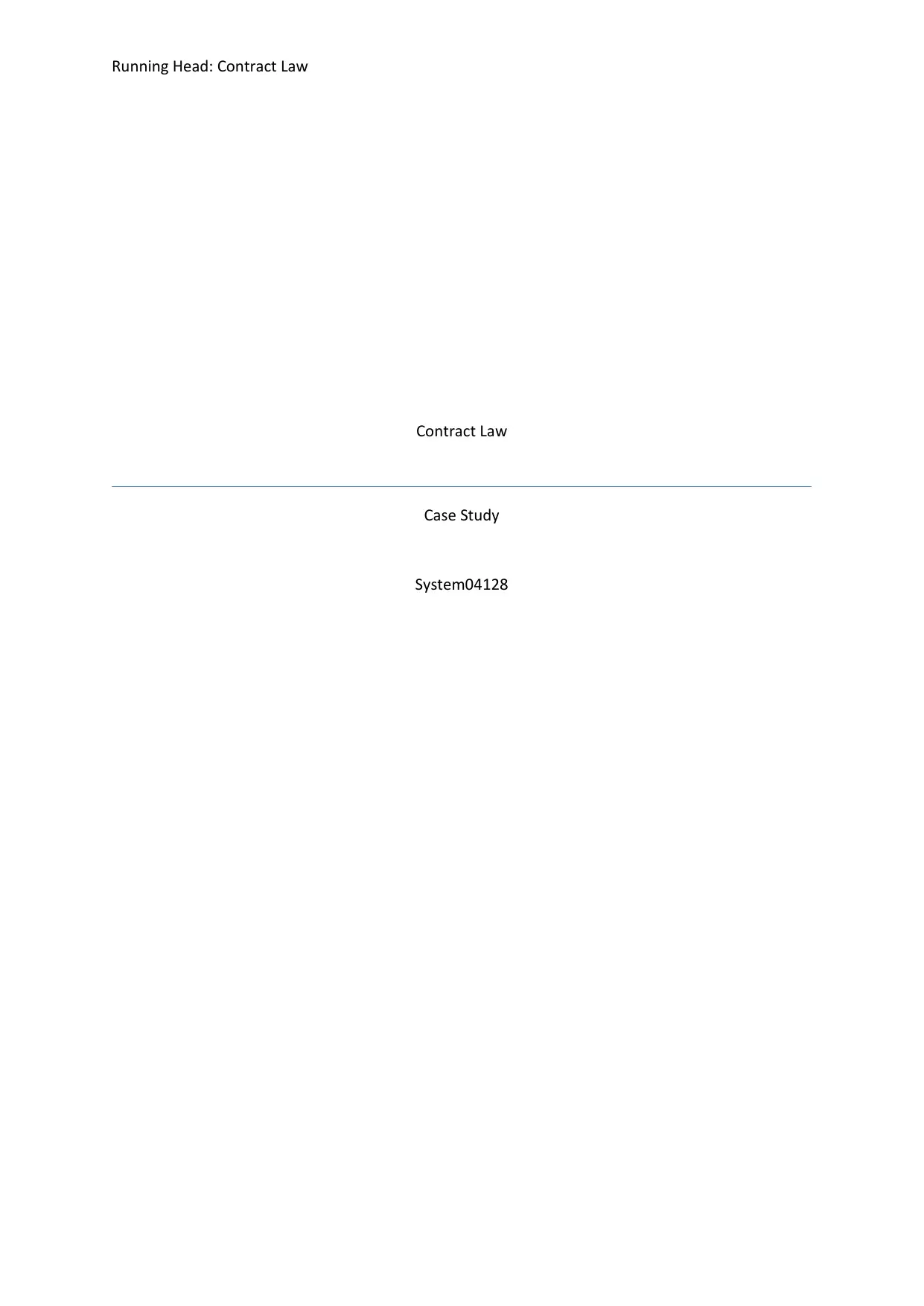
Running Head: Contract Law
Contract Law
Case Study
System04128
Contract Law
Case Study
System04128
Paraphrase This Document
Need a fresh take? Get an instant paraphrase of this document with our AI Paraphraser
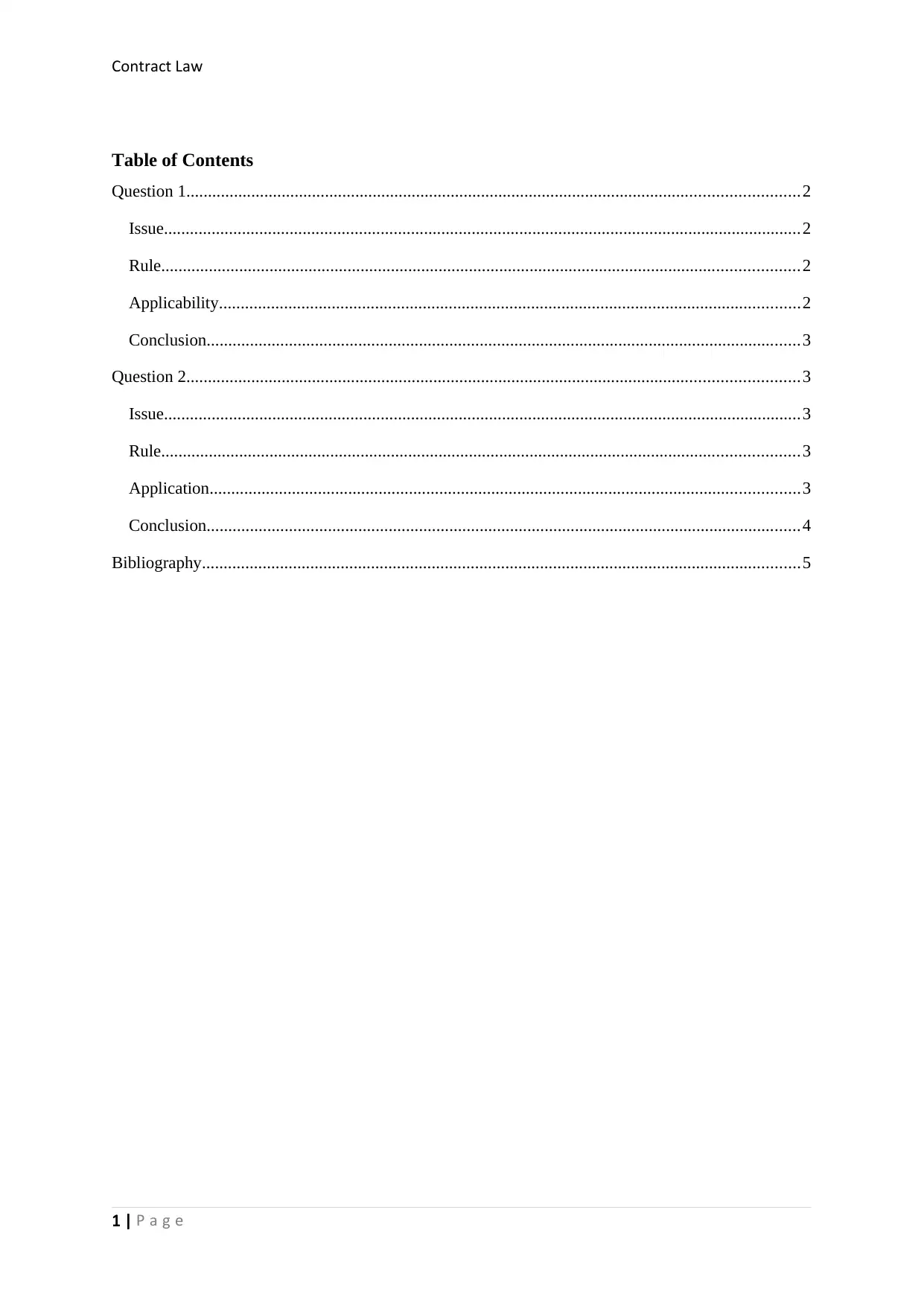
Contract Law
Table of Contents
Question 1.............................................................................................................................................2
Issue...................................................................................................................................................2
Rule...................................................................................................................................................2
Applicability......................................................................................................................................2
Conclusion.........................................................................................................................................3
Question 2.............................................................................................................................................3
Issue...................................................................................................................................................3
Rule...................................................................................................................................................3
Application........................................................................................................................................3
Conclusion.........................................................................................................................................4
Bibliography..........................................................................................................................................5
1 | P a g e
Table of Contents
Question 1.............................................................................................................................................2
Issue...................................................................................................................................................2
Rule...................................................................................................................................................2
Applicability......................................................................................................................................2
Conclusion.........................................................................................................................................3
Question 2.............................................................................................................................................3
Issue...................................................................................................................................................3
Rule...................................................................................................................................................3
Application........................................................................................................................................3
Conclusion.........................................................................................................................................4
Bibliography..........................................................................................................................................5
1 | P a g e
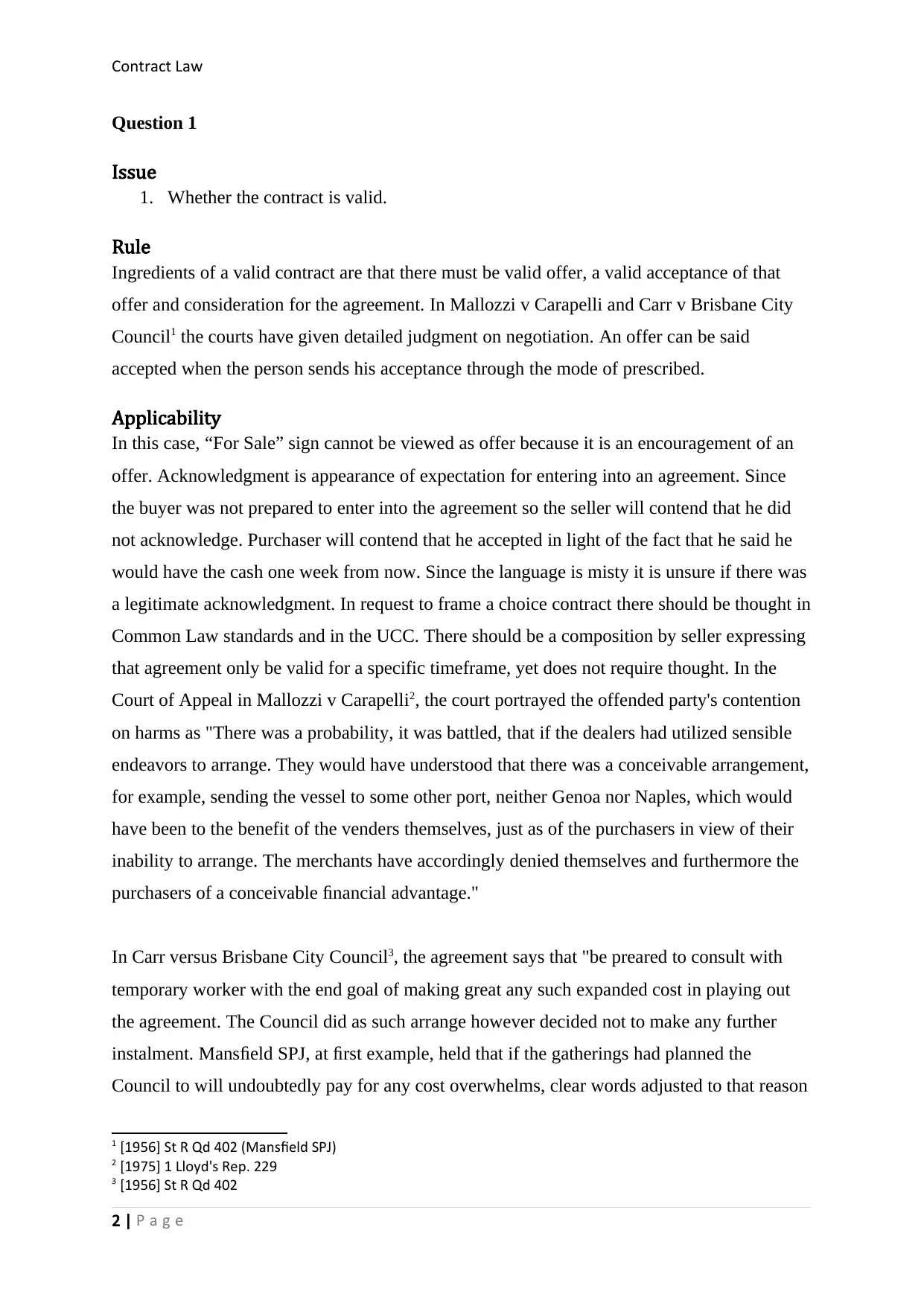
Contract Law
Question 1
Issue
1. Whether the contract is valid.
Rule
Ingredients of a valid contract are that there must be valid offer, a valid acceptance of that
offer and consideration for the agreement. In Mallozzi v Carapelli and Carr v Brisbane City
Council1 the courts have given detailed judgment on negotiation. An offer can be said
accepted when the person sends his acceptance through the mode of prescribed.
Applicability
In this case, “For Sale” sign cannot be viewed as offer because it is an encouragement of an
offer. Acknowledgment is appearance of expectation for entering into an agreement. Since
the buyer was not prepared to enter into the agreement so the seller will contend that he did
not acknowledge. Purchaser will contend that he accepted in light of the fact that he said he
would have the cash one week from now. Since the language is misty it is unsure if there was
a legitimate acknowledgment. In request to frame a choice contract there should be thought in
Common Law standards and in the UCC. There should be a composition by seller expressing
that agreement only be valid for a specific timeframe, yet does not require thought. In the
Court of Appeal in Mallozzi v Carapelli2, the court portrayed the offended party's contention
on harms as "There was a probability, it was battled, that if the dealers had utilized sensible
endeavors to arrange. They would have understood that there was a conceivable arrangement,
for example, sending the vessel to some other port, neither Genoa nor Naples, which would
have been to the benefit of the venders themselves, just as of the purchasers in view of their
inability to arrange. The merchants have accordingly denied themselves and furthermore the
purchasers of a conceivable financial advantage."
In Carr versus Brisbane City Council3, the agreement says that "be preared to consult with
temporary worker with the end goal of making great any such expanded cost in playing out
the agreement. The Council did as such arrange however decided not to make any further
instalment. Mansfield SPJ, at first example, held that if the gatherings had planned the
Council to will undoubtedly pay for any cost overwhelms, clear words adjusted to that reason
1 [1956] St R Qd 402 (Mansfield SPJ)
2 [1975] 1 Lloyd's Rep. 229
3 [1956] St R Qd 402
2 | P a g e
Question 1
Issue
1. Whether the contract is valid.
Rule
Ingredients of a valid contract are that there must be valid offer, a valid acceptance of that
offer and consideration for the agreement. In Mallozzi v Carapelli and Carr v Brisbane City
Council1 the courts have given detailed judgment on negotiation. An offer can be said
accepted when the person sends his acceptance through the mode of prescribed.
Applicability
In this case, “For Sale” sign cannot be viewed as offer because it is an encouragement of an
offer. Acknowledgment is appearance of expectation for entering into an agreement. Since
the buyer was not prepared to enter into the agreement so the seller will contend that he did
not acknowledge. Purchaser will contend that he accepted in light of the fact that he said he
would have the cash one week from now. Since the language is misty it is unsure if there was
a legitimate acknowledgment. In request to frame a choice contract there should be thought in
Common Law standards and in the UCC. There should be a composition by seller expressing
that agreement only be valid for a specific timeframe, yet does not require thought. In the
Court of Appeal in Mallozzi v Carapelli2, the court portrayed the offended party's contention
on harms as "There was a probability, it was battled, that if the dealers had utilized sensible
endeavors to arrange. They would have understood that there was a conceivable arrangement,
for example, sending the vessel to some other port, neither Genoa nor Naples, which would
have been to the benefit of the venders themselves, just as of the purchasers in view of their
inability to arrange. The merchants have accordingly denied themselves and furthermore the
purchasers of a conceivable financial advantage."
In Carr versus Brisbane City Council3, the agreement says that "be preared to consult with
temporary worker with the end goal of making great any such expanded cost in playing out
the agreement. The Council did as such arrange however decided not to make any further
instalment. Mansfield SPJ, at first example, held that if the gatherings had planned the
Council to will undoubtedly pay for any cost overwhelms, clear words adjusted to that reason
1 [1956] St R Qd 402 (Mansfield SPJ)
2 [1975] 1 Lloyd's Rep. 229
3 [1956] St R Qd 402
2 | P a g e
⊘ This is a preview!⊘
Do you want full access?
Subscribe today to unlock all pages.

Trusted by 1+ million students worldwide
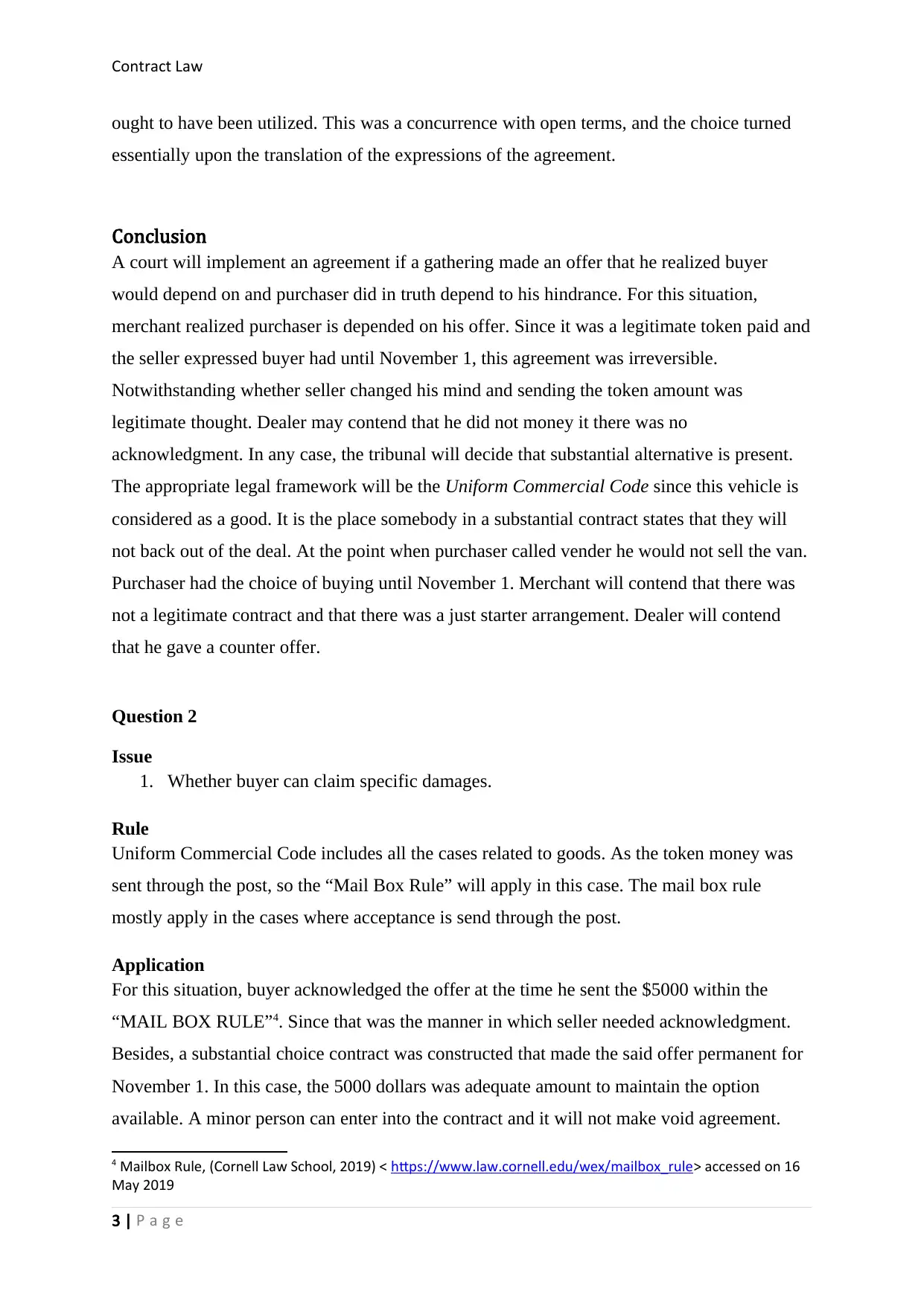
Contract Law
ought to have been utilized. This was a concurrence with open terms, and the choice turned
essentially upon the translation of the expressions of the agreement.
Conclusion
A court will implement an agreement if a gathering made an offer that he realized buyer
would depend on and purchaser did in truth depend to his hindrance. For this situation,
merchant realized purchaser is depended on his offer. Since it was a legitimate token paid and
the seller expressed buyer had until November 1, this agreement was irreversible.
Notwithstanding whether seller changed his mind and sending the token amount was
legitimate thought. Dealer may contend that he did not money it there was no
acknowledgment. In any case, the tribunal will decide that substantial alternative is present.
The appropriate legal framework will be the Uniform Commercial Code since this vehicle is
considered as a good. It is the place somebody in a substantial contract states that they will
not back out of the deal. At the point when purchaser called vender he would not sell the van.
Purchaser had the choice of buying until November 1. Merchant will contend that there was
not a legitimate contract and that there was a just starter arrangement. Dealer will contend
that he gave a counter offer.
Question 2
Issue
1. Whether buyer can claim specific damages.
Rule
Uniform Commercial Code includes all the cases related to goods. As the token money was
sent through the post, so the “Mail Box Rule” will apply in this case. The mail box rule
mostly apply in the cases where acceptance is send through the post.
Application
For this situation, buyer acknowledged the offer at the time he sent the $5000 within the
“MAIL BOX RULE”4. Since that was the manner in which seller needed acknowledgment.
Besides, a substantial choice contract was constructed that made the said offer permanent for
November 1. In this case, the 5000 dollars was adequate amount to maintain the option
available. A minor person can enter into the contract and it will not make void agreement.
4 Mailbox Rule, (Cornell Law School, 2019) < https://www.law.cornell.edu/wex/mailbox_rule> accessed on 16
May 2019
3 | P a g e
ought to have been utilized. This was a concurrence with open terms, and the choice turned
essentially upon the translation of the expressions of the agreement.
Conclusion
A court will implement an agreement if a gathering made an offer that he realized buyer
would depend on and purchaser did in truth depend to his hindrance. For this situation,
merchant realized purchaser is depended on his offer. Since it was a legitimate token paid and
the seller expressed buyer had until November 1, this agreement was irreversible.
Notwithstanding whether seller changed his mind and sending the token amount was
legitimate thought. Dealer may contend that he did not money it there was no
acknowledgment. In any case, the tribunal will decide that substantial alternative is present.
The appropriate legal framework will be the Uniform Commercial Code since this vehicle is
considered as a good. It is the place somebody in a substantial contract states that they will
not back out of the deal. At the point when purchaser called vender he would not sell the van.
Purchaser had the choice of buying until November 1. Merchant will contend that there was
not a legitimate contract and that there was a just starter arrangement. Dealer will contend
that he gave a counter offer.
Question 2
Issue
1. Whether buyer can claim specific damages.
Rule
Uniform Commercial Code includes all the cases related to goods. As the token money was
sent through the post, so the “Mail Box Rule” will apply in this case. The mail box rule
mostly apply in the cases where acceptance is send through the post.
Application
For this situation, buyer acknowledged the offer at the time he sent the $5000 within the
“MAIL BOX RULE”4. Since that was the manner in which seller needed acknowledgment.
Besides, a substantial choice contract was constructed that made the said offer permanent for
November 1. In this case, the 5000 dollars was adequate amount to maintain the option
available. A minor person can enter into the contract and it will not make void agreement.
4 Mailbox Rule, (Cornell Law School, 2019) < https://www.law.cornell.edu/wex/mailbox_rule> accessed on 16
May 2019
3 | P a g e
Paraphrase This Document
Need a fresh take? Get an instant paraphrase of this document with our AI Paraphraser
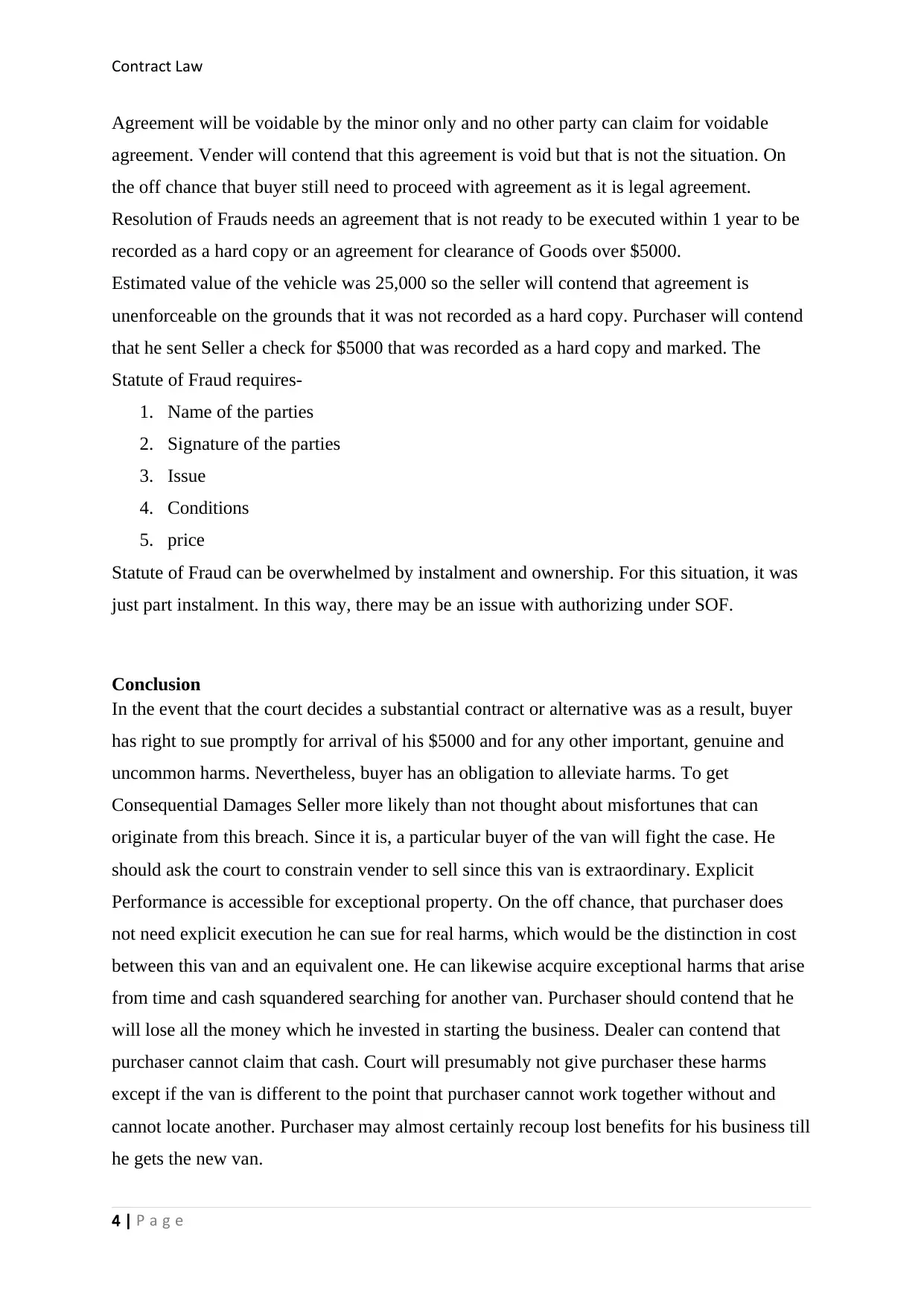
Contract Law
Agreement will be voidable by the minor only and no other party can claim for voidable
agreement. Vender will contend that this agreement is void but that is not the situation. On
the off chance that buyer still need to proceed with agreement as it is legal agreement.
Resolution of Frauds needs an agreement that is not ready to be executed within 1 year to be
recorded as a hard copy or an agreement for clearance of Goods over $5000.
Estimated value of the vehicle was 25,000 so the seller will contend that agreement is
unenforceable on the grounds that it was not recorded as a hard copy. Purchaser will contend
that he sent Seller a check for $5000 that was recorded as a hard copy and marked. The
Statute of Fraud requires-
1. Name of the parties
2. Signature of the parties
3. Issue
4. Conditions
5. price
Statute of Fraud can be overwhelmed by instalment and ownership. For this situation, it was
just part instalment. In this way, there may be an issue with authorizing under SOF.
Conclusion
In the event that the court decides a substantial contract or alternative was as a result, buyer
has right to sue promptly for arrival of his $5000 and for any other important, genuine and
uncommon harms. Nevertheless, buyer has an obligation to alleviate harms. To get
Consequential Damages Seller more likely than not thought about misfortunes that can
originate from this breach. Since it is, a particular buyer of the van will fight the case. He
should ask the court to constrain vender to sell since this van is extraordinary. Explicit
Performance is accessible for exceptional property. On the off chance, that purchaser does
not need explicit execution he can sue for real harms, which would be the distinction in cost
between this van and an equivalent one. He can likewise acquire exceptional harms that arise
from time and cash squandered searching for another van. Purchaser should contend that he
will lose all the money which he invested in starting the business. Dealer can contend that
purchaser cannot claim that cash. Court will presumably not give purchaser these harms
except if the van is different to the point that purchaser cannot work together without and
cannot locate another. Purchaser may almost certainly recoup lost benefits for his business till
he gets the new van.
4 | P a g e
Agreement will be voidable by the minor only and no other party can claim for voidable
agreement. Vender will contend that this agreement is void but that is not the situation. On
the off chance that buyer still need to proceed with agreement as it is legal agreement.
Resolution of Frauds needs an agreement that is not ready to be executed within 1 year to be
recorded as a hard copy or an agreement for clearance of Goods over $5000.
Estimated value of the vehicle was 25,000 so the seller will contend that agreement is
unenforceable on the grounds that it was not recorded as a hard copy. Purchaser will contend
that he sent Seller a check for $5000 that was recorded as a hard copy and marked. The
Statute of Fraud requires-
1. Name of the parties
2. Signature of the parties
3. Issue
4. Conditions
5. price
Statute of Fraud can be overwhelmed by instalment and ownership. For this situation, it was
just part instalment. In this way, there may be an issue with authorizing under SOF.
Conclusion
In the event that the court decides a substantial contract or alternative was as a result, buyer
has right to sue promptly for arrival of his $5000 and for any other important, genuine and
uncommon harms. Nevertheless, buyer has an obligation to alleviate harms. To get
Consequential Damages Seller more likely than not thought about misfortunes that can
originate from this breach. Since it is, a particular buyer of the van will fight the case. He
should ask the court to constrain vender to sell since this van is extraordinary. Explicit
Performance is accessible for exceptional property. On the off chance, that purchaser does
not need explicit execution he can sue for real harms, which would be the distinction in cost
between this van and an equivalent one. He can likewise acquire exceptional harms that arise
from time and cash squandered searching for another van. Purchaser should contend that he
will lose all the money which he invested in starting the business. Dealer can contend that
purchaser cannot claim that cash. Court will presumably not give purchaser these harms
except if the van is different to the point that purchaser cannot work together without and
cannot locate another. Purchaser may almost certainly recoup lost benefits for his business till
he gets the new van.
4 | P a g e
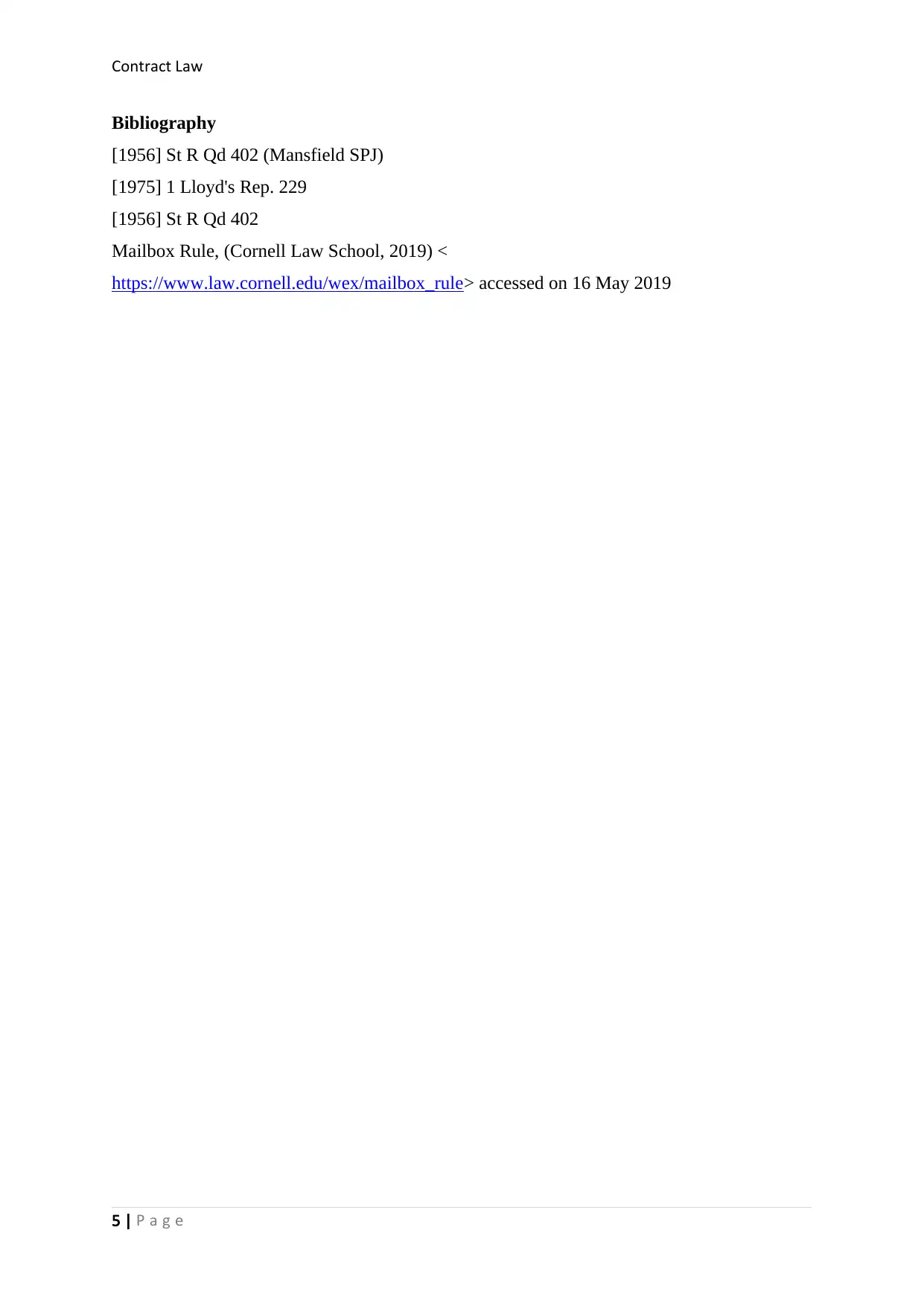
Contract Law
Bibliography
[1956] St R Qd 402 (Mansfield SPJ)
[1975] 1 Lloyd's Rep. 229
[1956] St R Qd 402
Mailbox Rule, (Cornell Law School, 2019) <
https://www.law.cornell.edu/wex/mailbox_rule> accessed on 16 May 2019
5 | P a g e
Bibliography
[1956] St R Qd 402 (Mansfield SPJ)
[1975] 1 Lloyd's Rep. 229
[1956] St R Qd 402
Mailbox Rule, (Cornell Law School, 2019) <
https://www.law.cornell.edu/wex/mailbox_rule> accessed on 16 May 2019
5 | P a g e
⊘ This is a preview!⊘
Do you want full access?
Subscribe today to unlock all pages.

Trusted by 1+ million students worldwide
1 out of 6
Related Documents
Your All-in-One AI-Powered Toolkit for Academic Success.
+13062052269
info@desklib.com
Available 24*7 on WhatsApp / Email
![[object Object]](/_next/static/media/star-bottom.7253800d.svg)
Unlock your academic potential
Copyright © 2020–2025 A2Z Services. All Rights Reserved. Developed and managed by ZUCOL.





